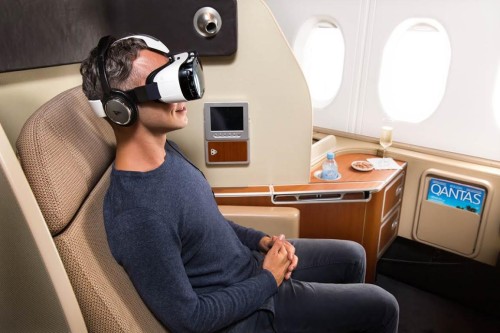Forget the seat-back screen and your bring-on-board tablet.
In an in-flight entertainment first, Australian carrier Qantas will soon be making Samsung’s virtual reality headsets, called Gear VR, available to premium passengers on some long-distance flights.
A three-month trial run begins in mid-March, when Qantas plans to make the headsets available to first-class passengers on some of the airline’s A380 flights between Australia and Los Angeles.
Visitors to Qantas first-class lounges in Sydney and Melbourne have headsets to test now.
Someday, Qantas says the VR technology “will transport customers to an immersive virtual world … and showcase the sights and delights of network destinations, new Qantas products and the latest in-flight blockbuster movies.”
But for now, Qantas is just giving passengers a virtual reality sampler of short features, or “vignettes,” filmed in Australia and produced by Palo Alto-based technology company Jaunt. The playlist that allows headset-wearers to watch a Qantas airplane take off and land and visit the top of the Sydney Harbor Bridge, a Qantas airport lounge and Kakadu, Australia’s largest national park.
“Travel and VR make a natural pair,” said Jaunt CEO Jens Christensen. “We’ve gone from no in-flight entertainment, to one drop-down screen, then screens in the seats, and now personal screens,” said Christensen.
“VR is the next step on the evolutionary scale,” he added. “Instead of a limited-size screen, a passenger is transported to a new location.”
That’s appealing if the technology is someday used to “virtually transport economy-class passengers in ultra-tight seating … to other more spacious ‘realities’ outside of the metal tube,” said Mary Kirby, founder of the Runway Girl Network. But widespread adoption by airlines “appears unlikely now” due in part to the high costs associated with the headsets and their handling, she added.
Another concern: making passengers sick. For some people find virtual reality experiences can sometimes trigger vertigo, nausea or worse.
“I think putting any device that simulates motion into something that is already moving will guarantee those air sickness bags won’t just be used for scribbling notes,” said Frank Catalano, a tech industry consultant and a columnist at GeekWire.
The stationary filming techniques used in the Qantas VR vignettes should help, said Jaunt’s Christensen, “When you’re in our environments, you’re stable. We found that eliminates the nausea.”
But what if the virtual reality experience is too good? Will travelers no longer need to actually go to the places they’ve “visited” during their flights?
“We think by transporting our customers to the immersive virtual worlds of destinations that [they] have never seen, the VR Gear will actually inspire our customers to travel more,” said Olivia Wirth, a Qantas executive for marketing and corporate affairs.
Catalano, a frequent traveler, agreed. “You simply can’t replicate the smells, the tastes, the serendipitous discoveries, the off-handed casual conversations with locals, the immersion into a new and different culture,” he said. “All virtual reality can do is stimulate the appetite for the real thing.”
(My story about virtual reality testing Qantas first appeared on CNBC in a slightly different format.)
Thanks for visiting Stuck at the Airport. Subscribe to get daily travel tidbits. And follow me on Twitter at @hbaskas and Instagram.
